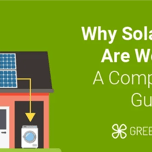- GreenMatch
- Blog
- Space Based Solar Power
Is Space-Based Solar Power Our Future? (April 2025)
What is Space-Based Solar Power?
Space-based solar power (SBSP) involves collecting the sun’s energy in space, and then wirelessly transmitting it to Earth. There are several advantages to solar energy. Although expensive, it is a great source of clean energy that has the capacity to provide more energy than the world consumes or is predicted to consume in the future.
A space-based solar power technological process includes using solar panels to collect solar energy in space with reflectors or inflatable mirrors that direct solar radiation onto solar panels, and then beaming it on Earth through a microwave or laser. The energy is then received on Earth via a microwave antenna (a rectenna).
According to the National Space Society, space-based solar power has the potential to dwarf all the other sources of energy combined. They argue that space-based solar power can provide large quantities of energy with very little negative environmental impact. It can also solve our current energy and greenhouse gas emissions problems.
The infographic below highlights information about space-based solar power, current related trends, and what different countries are doing in terms of research and funding.

If you would like to use this infographic on your website, use the embed code below:
Current Global Energy Consumption and Trends
The world’s energy consumption is only growing. According to a report by the University of Oxford’s Our World in Data, on the global primary energy consumption, the current world consumption is over 160,000 TWh annually. Solar energy contributes only 585 TWh.
Although there is an increase in renewable energy solutions, investments, and usage, oil, coal, and gas still generate more than 80% of the global energy that is consumed - with solar energy generating less than 1%.
Between 2004 and 2015, investments in renewable energy increased by 600% from £36.2 billion (US$46.7 billion) to £220.6 billion (US$284.8 billion).
Current predictions indicate that the world population will reach 9.7 billion by 2050. With the increase in population, the world energy consumption is also predicted to grow by 50% by 2050.
In addition, climate change impacts are accelerating. Although we generate a big percentage of the world energy from fossil fuels, fossil fuels contribute significantly to the increase of climate change. Many green countries are amending their climate policies to reduce the dependency on fossil fuels for energy production.
Comparatively, solar energy is the safest source of energy today - though it still only contributes a small percentage of the global energy production. The death rates from solar production are 1,230 times lower than coal, and it has one of the lowest CO2 emissions, at 5g CO2 eq per kWh.
Why Space-Based Solar Power?
Space-based solar power has several benefits; unlike solar panels on our roofs that can only generate electricity during the day, space-based solar power can generate continuous electricity, 24 hours a day, 99% of the year.
This is because, unlike Earth, the space environment does not have night and day, and the satellites are in the Earth's shadow for only a maximum of 72 minutes per night.
Space-based solar panels can generate 2,000 gigawatts of power constantly. This is 40 times more energy than a solar panel would generate on Earth annually. This is also several folds higher than the most efficient solar panels today.
What’s more, is that space-based solar power would generate 0% greenhouse gas emissions unlike other alternatives energy like nuclear, coal, oil, gas, and ethanol. The current source of energy that generates the lowest CO2 is nuclear power, which generates CO2 of 5g CO2 eq per kWh.
Space-based solar power generates almost 0% hazardous waste to our environment compared to nuclear power.
Why Are We Not There Yet?
While space-based solar power is an innovative concept, we are not able to fully launch a system into space yet. Launching a space-based solar system is very expensive. In fact, the cost is estimated to be about 100 times too high to compete with current utility costs.
One of the causes of the high costs is the high cost of launching the panels to space, which is mostly due to the high mass per watt generated by the current solar panels. In other words, the solar panels are currently too heavy per watt generated to make it feasible.
Currently, the cost of launching in space is estimated to be £7,716 per kilogram - approximately £154 per watt. In comparison to the cost that homeowners pay today, which is approximately £2 per watt peak, the cost in space is extremely high to be competitive. In UK homes, the installation cost of solar panels can be as low as £1.5 per watt, making for a relatively cheap solar panel installation.
Other reasons for high costs include the overall high transport costs to space. This is because transporting all other materials that are needed to space would require many space shuttle launches, and these space shuttles are currently not reusable. So, not only is the launch of solar panels themselves expensive, but the additional materials needing to be transported is also expensive.
A lot of research and engineering is still ongoing to find the most feasible way to launch space-based solar panels and launch systems, at a lower cost.
The environment out in space also has several hazards that could cause damage to the solar panels. These include space debris and extreme solar radiation, which could degrade the solar panels up to 8 times faster than panels installed on Earth.
Finally, there is a potential of wasting large amounts of energy when transporting or during transmission from space to Earth. Therefore, scientists and engineers must continue their R&D efforts to ensure little to no energy is lost during the process.
Current SBSP Projects and Progress
The key players in SBSP include China, the US, and Japan, who have shown progress in terms of technology advancements, partnerships, and launch plans.
China is already progressing to launch into space. The China Aerospace Science and Technology Corporation plans to launch small to medium solar satellites in the stratosphere that can harness energy in space between 2021 and 2025.
China also plans to generate one megawatt of energy from space-based solar panels by 2030, and to be operating a commercially viable solar space station by 2050.
In the US, there are ongoing partnerships and investments. For example, a $100 million partnership between Northrop Grumman and U.S. Air Force Research Laboratory has been established to provide advanced technology for SBSP.
Also in the US, a $17.5 million collaboration between Northrop Grumman Corporation and Caltech was set up to develop the space solar power project called ‘The Space Solar Power Initiative’. The initiative’s goal was to develop scientific and technological innovations that would enable a space-based solar power system generate electricity at a cost comparable to current sources of electricity.
There has been ongoing research and technological advancements. In the US, the development of the SPS-ALPHA Mark-II concept is underway. This, if successful, would enable construction of huge platforms in space that can remotely deliver tens of thousands of megawatts of electricity to Earth, using wireless power transmissions. This will also enable delivery of affordable power to Earth and on space missions.
In addition, progress is being made to build reusable launch systems. Success in this will lower the cost of transport to space and overall cost of space-based solar power. An example is SpaceX, that is currently working on reusable launch vehicles that can be used for transport to space.
In Japan, researchers successfully transmitted electric power wirelessly using microwaves. Researchers transformed 1.8 kW of electric power into microwaves and accurately transmitted it into a receiver that was 55 metres away. This was a technological advancement towards bringing SBSP closer to reality. Japan also made space-based solar systems part of its future space exploration vision.
Future Outlook for SBSP
Fossil fuels are finite and can eventually run out. According to predictions, oil and natural gas could run out in 50 years and coal production in 115 years. With ongoing research and investments, there is a high possibility that space-based solar power is the viable future of solar power.
If the cost of space-based solar power can be lowered, it is likely to be a major source of sustainable energy that cannot diminish. Major players like China, who already have timelines of implementing the technology in space, may be able to provide some key learnings for future improvements in the technology.
We strive to connect our customers with the right product and supplier. Would you like to be part of GreenMatch?




